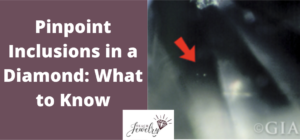
Unless you opt for a rare flawless grade, you’ll have to decide which types of diamond inclusions to tolerate.
One blemish often present is a pinpoint inclusion.
These internal crystals are typically invisible to the naked eye but can still affect a diamond’s overall quality.
Let’s explore pinpoint inclusions, including how they’re shown on grading reports, their influence on a diamond’s price, if they can be removed, and how they compare to other inclusions.
What is a Pinpoint Inclusion in a Diamond?
A pinpoint inclusion in a diamond is a small black or white crystal that appears as a dot under 10x magnification. It’s one of the most common inclusions, but it rarely has a significant impact on the diamond unless several are clustered together.
When several pinpoints are near each other, the group is called a cloud inclusion.
Inclusions can prevent light from properly entering and exiting a diamond, but the size and color of most pinpoints don’t diminish its light performance.
Many diamond buyers are also concerned about how inclusions affect durability.
Internal and external imperfections in a diamond can pose risk for further damage, but embedded pinpoints are the least likely to cause structural issues.
To see a real example of a diamond with pinpoint inclusions, check out this one-carat round cut that earned a VVS2 clarity grade.
Zoom in on the diamond and try to identify where they’re located.
If you’re having a difficult time, that’s because of their small size and minimal impact, especially on a VVS2 diamond.
Pinpoints on Diamond Grading Reports
The Gemological Institute of America (GIA), American Gem Society, and other organizations grade diamonds so you know its quality across many areas including cut, color, carat, and clarity.
Pinpoint inclusions are part of the clarity category and recognized on the report’s clarity characteristics plot.
For example, let’s examine the GIA report for this diamond from Blue Nile.
It’s graded VVS1, so although it earned a high grade for its minimal inclusions, it features a few small ones.
The grading report, pictured below, shows a few instances of pinpoints scattered around the pavilion view.
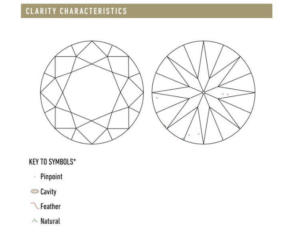
The clarity plot, combined with the high-resolution photo of the diamond, gives you confidence these pinpoints have no noticeable impact on its appearance or brilliance.
This is especially true because there are no clusters of pinpoints showing on the report.
In other cases, pinpoints are so negligible they won’t appear on the clarity plot.
Instead, the gemologist writes a comment in the “Additional Grading Information” section that reads “Pinpoints not shown.”
Below, I’ve posted an example of where to find those comments on the report.
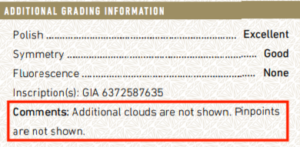
Even if they don’t appear on the clarity plot or in the comments section, there could still be pinpoints in the diamond.
In many cases, a cloud inclusion is made up of multiple pinpoints clustered together, so the plot might feature that label.
How do Pinpoint Inclusions Affect a Diamond’s Price?
The best way to understand how much you can save buying a diamond with pinpoints versus one without is to compare the prices of flawless (FL) and internally flawless (IF) diamonds to ones with pinpoints, where all other qualities are equal.
For example, this 1.5-carat diamond is internally flawless and costs $20,340.
This one has those same qualities, except its graded VVS1 clarity because of several pinpoint inclusions scattered throughout it.
Its price is $16,290.
The comparison demonstrates the presence of pinpoint inclusions can lower the price of a diamond from 10-35 percent, depending on how many pinpoints there are and how they impact its overall appeal.
Can They be Removed?
Diamond manufacturers choose not to remove pinpoints because they have minimal impact on the diamond’s overall appearance and brilliance.
Any attempt to remove them would likely do more damage than it’s worth.
Additionally, it could require reducing its carat weight, so the diamond would sell for a lower price.
It’s a cost-benefit analysis on behalf of the manufacturer. Although it might increase in value because the pinpoints aren’t there, the lower carat weight would bring the price down even more.
One common way to improve the clarity of a diamond is through laser drilling holes to improve the appearance of inclusions or remove them.
While this may enhance the appearance of a diamond with significant, noticeable inclusions, this method would diminish the overall quality if done only to remove a pinpoint.
Additionally, many clarity-enhancement methods focus on removing dark inclusions, and because most pinpoints are transparent, it’s unnecessary.
How do Pinpoints Compare to Other Inclusions?
If you’re considering a diamond to purchase, pinpoints likely aren’t the only type of inclusion that will be present.
Other types of diamond inclusions are indented naturals, cavities, and bruises.
Those are a distinct type of flaw compared to pinpoints, but others have a closer relationship.
For example, twinning wisps are formed by a string or series of pinpoints or clouds.
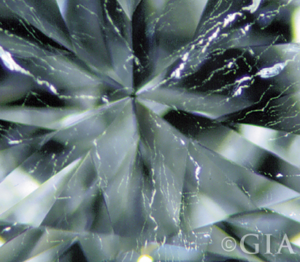
Although twinning wisps are its own type of inclusion, it features pinpoints. If you’re reading a diamond’s report, and the clarity plot includes twinning wisps, that could be a sign pinpoints are present.
Cloud inclusions are generally three or more pinpoints close together.
When separated from each other, pinpoints are nearly invisible, but when they’re knit closely together, it can create a hazy or milky appearance.
Should You Buy a Diamond with Pinpoint Inclusions?
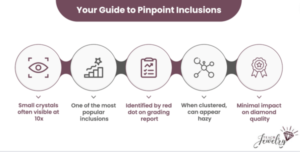
Don’t discard a diamond because of pinpoints.
Many diamonds have them, and they’re often the inclusion with the least impact.
Review the grading report to know where they’re located and whether they form larger inclusions such as twinning wisps or clouds.
But if there are a few individual ones scattered throughout the diamond, it can still be the right purchase.
I recommend starting your search at SI1 clarity if the diamond weighs one carat or less. From there, move up the scale until you find one that’s eye-clean.
By understanding diamond pinpoints and other inclusions, you’ll know how to factor these qualities into your final decision.

Jacob Clarke
Jacob Clarke is the founder of TeachJewelry.com.
He earned an Applied Jewelry Professional Diploma from the Gemological Institute of America (GIA) and now brings you essential information about diamonds, settings, and more.
Jacob has consulted with leading jewelry brands, and his work has been cited in Clean Origin, Diamond Nexus and industry publications.
He's also a member of the International Gem Society.
He enjoys discussing jewelry with readers, so contact him with any questions at jacob.clarke@teachjewelry.com.













